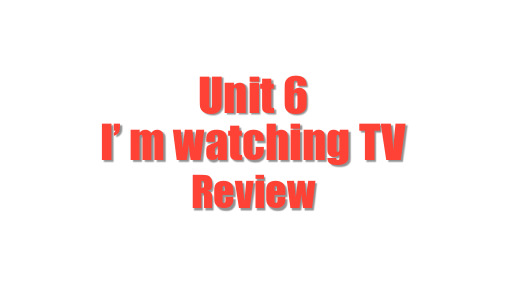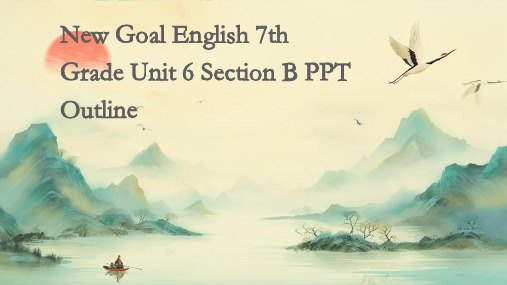新目标英语七年级下unit6全单元课件
英语]-新课标人教版本新目标七年级下Unit6课件[整理
![英语]-新课标人教版本新目标七年级下Unit6课件[整理](https://img.taocdn.com/s3/m/c051b18ce009581b6bd9eb78.png)
h
21
Pair work
Practice the conversation below. Then make your own conversations.
Hi, Alice? This is Bob.
Oh, hi. How’s it going?
Not bad. Terrible. It’s windy.
h
41
3b Look at the pictures of France. Then fill in the blanks.
It’s winter in France. The weather is w__in_d_y_ and
_c_o_ld__. People are wearing _c_o_a_ts_ and scarves. But everyone is having a good time. Friends aree_at_in_g_/d_rinking/meetin in a restaurant. In a _p__ar_k_ , a musician is _p_la_y_in_g the guitar and some boysa_re__p_la_yi_n_g_f_oo_t_ba. llOne man is t_a_k_in_g_ a p__h_o_to_.
Role play a conversation between Maria and Sam. Ask and answer these questions :How’s it going? What are you doing? How’s the weather?
h
26
Task III Talking about the weather and activities.
新目标初一下unit6课件

3b Bring in some photos of your own (or draw some pictures of you and your family or friends) and write about them.
今天是星期天,天气很好。海滩上真热闹, 有很多人正在休闲。请你根据下画写一篇 文章,描述一下人们正在做些什么。 提示词:be doing, there be, surf, play beach volleyball, build sand castles, take pictures, relax, walk a dog…(后附范文)
Ukraine 9:45 p.m.
Beijing 2:45 a.m.
Sochi 4:00 p.m. Beijing 8:00 p.m.
Activity 1: Have you ever been to another country before? Do you have any stories about jet lag(时差)? Please share with you group members. Activity 2: Make a telephone call and ask what each other is doing in pairs. Student A and Student B are in two different places in the world.
1c Listen and complete the chart.
Names Alice Mike Lisa Places supermarket Activities
1d Listen again. Check your answers in 1c.
新目标英语七年级下unit6全单元课件

Students listen to a passage with missing information and fill in the missing information based on what they hear. This exercise helps them understand the overall meaning while focusing on specific details.
vocabulary.
02
Reading comprehension
The courseware provides reading materials with questions and
exercises to help students understand and apply the theme
Inferring
Drawing inferences and conclusions from the text, beyond what is explicitly stated.
Critiquing
Evaluating the credibility, accuracy, and fairness of the
01
Unit Introduction
Unit Theme
The unit theme is "Festivals and Celebrations". It focuses on different festivals and celebrations around the world, including traditional and modern festivals.
information presented in a text.
新目标英语七年级下学期第六单元课件

Grammar point parsing
The courseware covers the key grammar points in the text, such as present simple tense, present continuous tense, and simple past tense.
The text also includes elements of mystery and suspense, keeping the reader engaged throughout.
Words and expressions
The courseware provides a list of new words and expressions that are essential for understanding the text, such as "treasure hunt," "brave," "island," and "mysterious."
It provides examples of how to use these grammar points in sentences and encourages students to practice their grammar skills through exercises and activities.
The text is a story about a group of friends who go on a journey to find a hidden treasure. It involves various challenges and adventures that test their friendship and bravery.
人教新目标英语七年级下Unit6

新目标英语七年级下Unit 6 It ' s raining !Section A Period 1审核人:宋成建备课时间:第三周拟使用时间:第四周星期一教师寄语:First think and then speak.先思后说)学习目标:1. 学习P31-P33新单词及短语;2. 灵活运用本课的重点句型How' s the weatherlt ' s raining.3. 通过自主学习,合作学习等学习策略,训练学生的逻辑思维,快速反应能力和实践能力,使学生熟练运用英语表达天气情况。
前置测评:听写本课的单词及短语。
认定目标:师生共同认定。
自主探究:1>听录音,学习新单词及短语;2、学生看P31 1a,将词语与图片匹配;学生独立完成,然后小组交流,并展示答案。
师评析。
3、1b听录音,将城市名填在方框内;听后独立完成,然后小组交流,展示答案。
师评析。
4、1c结对活动:师生评价,选出活动较好的小组。
5、学生看P32 2a,听对话,学生先独立完成,然后小组交流,展示答案。
师评析。
6、学生看2b,再听一遍录音,学生先独立完成,然后小组交流,展示答案。
师评析。
7、结对活动2c:小组成员交替扮演角色练习对话,小组展示,师生评价,选出活动较好的小组。
题组训练:按要求写单词。
1. sun (形容词)_______2. take (-ing形式)________3.join (单数第三人称)__________4. windy (名词形式) _____5. music音乐家)___________6. lie (-in影式) _______7. boring原义词)_______8. cold犀义词)_ 归纳总结:学生总结本节课的重点内容:达标测评:一、会话配对。
新目标英语七年级下Unit 6 It ' s raining !)1. Do you like cold weather? )3. What are you doing? )4. How ' s it going? )5. How do you spell、句型转换,一空一词。
Unit 6 单元复习课件-七年级英语下册同步备课系列(人教新目标Go for it!)

My parents aren’t at home. We can eat out. Laura: Yeah. I’d love to. Jenny: Let’s meet at my home first. Come at half past six. Laura: OK. See you then.
Words
10. 儿童 n. _c_h_il_d_____ 11. 可口的,美味的 adj. _d_e_l_ic_i_o_u_s 12. 房子 n. __h_o_u_s_e____ 13.希望 v. __w__is_h__ 14.出去吃 __e_a_t_o_u_t__ 15.男人,人 n. ___m_a_n____ 16.一个...另一个...__o_n__e._.._t_h_e_o_t_h_er... 17.一些...另一些..._s_o_m__e_.._.o_t_h_e_r_s_.._. 18.美国__A_m__e_r_ic_a
He isn’t reading the newspaper. 他没在看报纸。
Be (Am, Is, Are) + 主语 + v-
ing + 其他?
一般 疑问句
肯定回答:Yes, + 主语 + be.
否定回答:No, + 主语 + be
+ not.
—Are they playing soccer? 他们在踢足球吗? —Yes, they are./ No, they aren’t. 是的,他们在踢。/不,他们没在踢。
新目标英语七年级下Unit6SectionB

05
Homework and suggestions after class
Homework assignment
Summary
Summarize the main points and key information from the lesson.
Vocabulary practice
Use the new vocabulary words in a sentence of your own creation.
Responding to questions
Teach students how to answer questions based on what they have heard, using appropriate language and grammar.
04
Classroom activities and interactions
Grammar exercises
Complete the grammar exercises provided in the workbook.
Reading comprehension
Read the assigned passage and answer the comprehension questions.
Learning objectives
Students will be able to read and understand more complex texts.
Students will be able to speak fluently and confidently in English.
Students will be able to write clearly and effectively in English.
七年级英语下册《Unit6 I’m watching TV Self check》课件 (新版)人教新目标版

I. 写出下列动词现在分词形式。
cleaning working 1. clean _______ 2. work _______ 3. watch watching _______ eating reading waiting 4. eat ________ 5. read _______ 6. wait ________
6. Jim stands under the tree. (改用现在进行时表达) Jim is standing under the tree. ___________________________________ 7. He’s carrying water for the old woman. (改为一般疑问句) Is he carrying water for the old woman? ___________________________________ 8. They are cleaning their classroom. (对划线部分提问) What are they cleaning? ___________________________________
watching talking eating
using exercising living
swimming shopping
Jack is playing basketball now.
2. Write questions to complete the conversation.
What are you doing A: Hey, Bob! ____________________? (what) B: I’m listening to the radio. A:________________________? (play soccer): Sounds good, but this talk show is interesting. A: ___________________? (what, Tony) What’s Tony doing B: Oh, he’s studying for a test. Is Steve studying for a test, too A:____________________________? (Steve, too) B: No, he’s not. I think he can play soccer with you.
- 1、下载文档前请自行甄别文档内容的完整性,平台不提供额外的编辑、内容补充、找答案等附加服务。
- 2、"仅部分预览"的文档,不可在线预览部分如存在完整性等问题,可反馈申请退款(可完整预览的文档不适用该条件!)。
- 3、如文档侵犯您的权益,请联系客服反馈,我们会尽快为您处理(人工客服工作时间:9:00-18:30)。
who,句子的时态是现在进行时,按照现
在进行时基本的结构可以得到答案。
10. They are doing their homework.
(变为一般疑问句)
____________________________ Are they doing their homework?
解析:现在进行时的一般疑问句只需要把
guitar.
The Present Continuous Tense
现在进行时态
1. 定义:表示现在正在进行的动作。 2. 构成:be (am, is, are) + 动词ing形式
主语+be + v. –ing+其他
主语+am / is / are + 现在分词+其他 3. 句中常有now, listen, look,等词。
4)read “看、读”。其宾语常是“书、报、杂志”等。
He is reading a book. 他正在看书。
体会下边的话:看,大卫正在看黑板。他能看
见一位女孩在看书,她没有看电视。
Unit 6
I’m watching TV.
Section B
Review: 现在进行时与一般现在时
现在进行时是表示一个动作正在发生或 进行。(now, look, listen等) 一般现在时表示现在的状态或经常的,
A: 他们正在做什么? B: They are…
A: What are they doing? B: They are dancing.
A: 她正在做什么? B: She is …
A: What is she doing? B: She is drawing.
Exercises
1. My parents are _____ TV now.
习惯性的动作。(频度副词,every…等)
Look! 区别下面的几组句子: I do my homework every day. I am doing my homework now. He cleans his room every afternoon. He is cleaning his room now. 区别这两种时态主要是看时间状语。 两种时态区别主要体现在动词的形式上。
A. reading
C. watching C
B. looking
D. seeing
解析:此题考查固定短语“看电视” 为watch TV。
2. Don’t talk here. Grandparents ____. A. sleep B. is sleeping C. C are sleeping D. sleeping
He is playing basketball.
A: 他正在做什么? B: He is…
A: What is he doing? B: He is eating.
A: 他正在做什么? B: He is…
A: What is he doing? B: He is playing basketball.
解析:此句的时态为现在进行时,并且
句子的主语是第三人称的复数形式。
3. Look!Who is _____ in the pool? A. swims B. swimming B C. swiming D. swim 解析:句首的单词look已经提醒我们这
个句子要用现在进行时,注意swim的现
在分词形式为swimming,而不是其他
1a Match the activities with the pictures.
i 1. watching TV __ d 2. cleaning __ g 3. reading a newspaper __ a 4. talking on the phone __ h 5. listening to a CD __
形式。
4. My brother and I _____ at school. A. am B. is C. C are D. /
解析:句子的主语是两个人,所以谓 语动词要用are。
5. —Is Ann _____ American girl? —No,she isn’t. She’s _____ English girl. A. a;an B. an;a D C. a;a D. an;an 解析:American 和English开头字
6. using the computer __ e 7. making soup ___ b 8. washing the dishes __ c f 9. exercising ___
2b Listen again. Fill in the blanks.
Jack: Hello, Steve. Steve: Hi, Jack. Jack: What _____ are you ______, doing Steve? Steve: I’m ___________. watching TV What about you? Jack: I’m _______________, listening to a CD but it’s kind of _______. boring Steve: Yeah, my TV show is also not very __________. interesting Do you want to _____ go to the movies? Jack: That sounds good.
What do people often do in the pool? Swim. What is he doing now? He is swimming.
What do people usually do in the library? Read books. What is he doing now? He is reading a book.
• write
writing taking having making coming arriving dancing
动 词 现 在 分 词 变 型
• take • have
• make
• come • • arrive • dance
• leave
leaving
• sit
sitting
动 词 现 在 分 词 变 变 变
2d Role-play the conversation.
Jenny: Hello? This is Jenny. This is… “我是…”
这是打电话用语。 如果问对方,则用Is that…? “你是…吗?” 或者Who’s that? “你是谁?” Laura: Hi, Jenny. It’s Laura here. Jenny: Oh, hi, Laura. What are you doing? Laura: Not much. I’m just washing my clothes. What about you? not much 没什么事
I’m eating dinner.
What is he doing?
He is swimming.
What is Tom doing?
He is drawing.
What is she doing?
She is dancing.
What is Mary doing?
She is playing the
Have a look
do→doing
(说出动词加ing的规律 ) write→writing run→running
swim→swimming stop→stopping get→getting 以重读闭音节 结尾的动词, 如果末尾只有 一个辅音字母, 应先双写这个 字母,再加ing。
watch→watching dance→dancing clean→cleaning come→coming eat→eating read→reading talk→talking have→having arrive→arriving 以不发音字母e 结尾的动词, 先去掉e,再加 -ing。
watch TV 看电视
区分:watch, see, look, read “看”
1)watch “观看、注视”。指长时间看某一活动的场面, 如:看电视、比赛、表演、赏月等。
他喜欢看电视。 He likes watching TV. 2)look 强调发出看的动作 look at sth. 看某物 look at the blackboard 看黑板 Look!They are swimming. 3)see 强调“看”的结果 I can see some birds in the tree. 我能看见树上有一些鸟。
be动词提前就可以,因此在这个句子中只
需把are提前就可以了。
read a newspaper
use the computer
do/wash the dishes
go to the movies
clean
talk on the phone
listen to a CD
make soup
exercise
sing→singing
play→playing 一般在动词原形末 尾加-ing。
Can you add -ing after the words?
do ing
eat ing
write -writing
run ning
dance -dancing swimming
watching come -coming get ting
正在…
What are you doing now? I am walking.
What are you doing?
